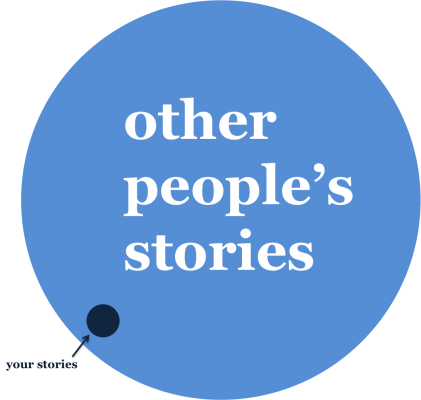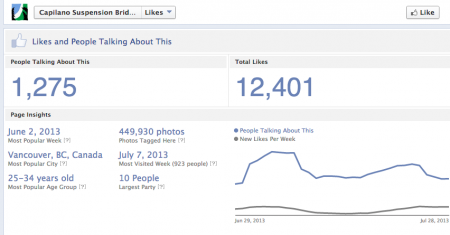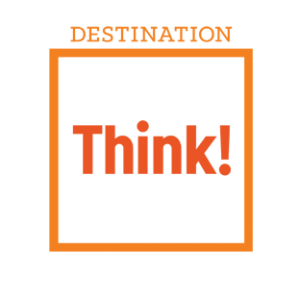Storytelling
Destination Marketing is storytelling. And by now every DMO is generating content and distributing it through their own channels. Content is shared, people engaged, fans, followers and engagement is measured and reported. Social Media is firmly established as an important channel.
But if you want to start thinking like a level 4 DMO, one of the first things to do is look beyond storytelling through your own channels. The stories people share with each other in their own networks (often private and invisible to marketers) is more credible and trusted than any story a DMO creates.
Evidence
At #SoMeT13AU, Carl McCarthy from Facebook shared that over 70% of travellers update their status and/or share photos while on holiday. Let’s look at the Capilano Suspension Bridge, a populair tourism attraction in Vancouver. The public stats for their Facebook page show a respectable 12,401 fans with 1,275 people talking. But look at an often overlooked little statistic; 449,930 photos have been tagged with this tourism experience.
Let’s look at ten of the more populair attractions in Vancouver (selected by myself from memory).
| attraction | likes | photos tagged |
| Capilano Suspension Bridge Park | 12,404 | 449,930 |
| Vancouver Aquarium | 30,777 | 694,427 |
| Grouse Mountain Resort | 22,597 | 148,824 |
| Vancouver Art Gallery | 20,631 | 64,857 |
| Cypress Mountain | 18,270 | 161,182 |
| Granville Island | 15,445 | 265,967 |
| Science World | 14,480 | 87,268 |
| Museum of Anthropology | 6,766 | 26,146 |
| The Vancouver Lookout | 3,003 | 17,747 |
| Dr. Sun Yat-Sen Chinese Garden | 2,446 | 29,980 |
| Total | 146,819 | 1,946,328 |
Collectively, these pages have 146,819 fans. More than 3x the fans of Tourism Vancouver’s page. The total number of photos shared is almost 2 Million! If we consider that the average Facebook user has 150+ friends it means that those 2 million photos probably reached tens of millions of people. And those are just photos of attractions where people geotagged the photo. The true number of tourism related photos shared online for Vancouver is exponentially larger. That’s the real Facebook marketing.
There’s also plenty of research that demonstrates the effect of somebody posting a Facebook picture has on their network for example. Anywhere from 20% to 52% of consumers have taken a trip to a destination as a direct result of seeing a photo posted by a friend.
And that’s just Facebook.
Implications for DMOs
The implication is that a DMO marketer needs to look beyond their own channels. Most of the conversation is happening elsewhere and often invisible. But as you can see in my examples above, that doesn’t mean you can’t measure it. The success of growing tourism in your destination goes beyond the activity the DMO manages. It’s a collective effort.
- First thing to do is collaborate with your operators to make sure they make the most out of their own social channels.
- Second is to actively grow the number of visitors sharing their experiences through their social channels. Through encouragement but also by enabling sharing.
- Third, and this is where we get into the future of destination marketing, by actively managing your destination to give visitors more reasons to share their experiences and mitigate any negative stories.
[By the way, I only used Vancouver as an example because I live there, no other reason]
Tags: destination management, DMO, service design, social media


